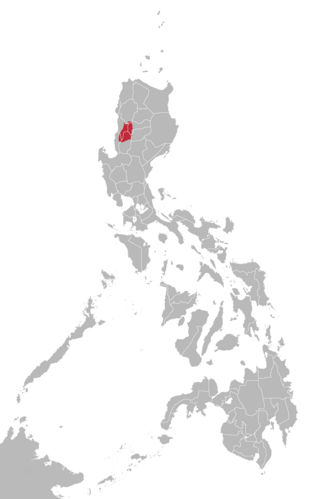Related Research Articles

Kankanaey is a South-Central Cordilleran language under the Austronesian family spoken on the island of Luzon in the Philippines primarily by the Kankanaey people. Alternate names for the language include Central Kankanaey, Kankanai, and Kankanay. It is widely used by Cordillerans, alongside Ilocano, specifically people from Mountain Province and people from the northern part of the Benguet Province. Kankanaey has a slight mutual intelligibility with the Ilocano language.
Ngadha is an Austronesian language, one of six languages spoken in the central stretch of the Indonesian island of Flores. From west to east these languages are Ngadha, Nage, Keo, Ende, Lio, and Palu'e. These languages form the proposed Central Flores group of the Sumba–Flores languages, according to Blust (2009).
Mapoyo, or Mapoyo–Yavarana, is a Carib language spoken along the Suapure and Parguaza Rivers, Venezuela. The ethnic population of Mapoyo proper is about 365. Yabarana dialect is perhaps extinct; 20 speakers were known in 1977. An additional dialect, Pémono, was discovered in 1998. It was spoken by an 80-year-old woman and has since gone extinct.
Bruu is a Mon–Khmer dialect continuum spoken by the Bru people of mainland Southeast Asia.

Maʼya is an Austronesian language of the Raja Ampat islands in Southwest Papua, Indonesia. It is part of the South Halmahera–West New Guinea (SHWNG) subgroup and is spoken by about 6,000 people in coastal villages on the islands Misool, Salawati, and Waigeo, on the boundary between Austronesian and Papuan languages.

Siona is a Tucanoan language of Colombia and Ecuador. The language is essentially the same as Secoya, but speakers are ethnically distinct.
Lalo is a Loloish language cluster spoken in western Yunnan, China by 300,000 speakers. Speakers are officially part of the Yi nationality, and Chinese linguists refer to it as "Western Yi" due to its distribution in western Yunnan. Lalo speakers are mostly located in southern Dali Prefecture, especially Weishan County, considered the traditional homeland of the Lalo. Historically, this area is the home of the Meng clan, who ruled the Nanzhao Kingdom (737–902 CE). Many speakers of Core Lalo dialects claim to be descendants of the Meng clan.
Machiguenga (Matsigenka) is a major Arawakan language in the Campa sub-branch of the family. It is spoken in the Urubamba River Basin and along the Manu River in the Cusco and Madre de Dios departments of Peru by around 6,200 people. According to Ethnologue, it is experiencing pressure from Spanish and Quechua in the Urubamba region, but is active and healthy in the Manu region. It is close enough to Nomatsiguenga that the two are sometimes considered dialects of a single language; both are spoken by the Machiguenga people. Nanti is partially mutually intelligible but ethnically distinct.
Waurá (Wauja) is an Arawakan language spoken in the Xingu Indigenous Park of Brazil by the Waujá people. It is "partially intelligible" with Mehináku. The entire population speaks the language.
Kaba (Kabba), or Kabba of Goré, is a language of the Sara people in Central African Republic and Chad, with around 100,000 speakers.
Samre, is a nearly extinct Pearic language of Thailand and, formerly, Cambodia. The language is evidently extinct in Cambodia, but a 1998 survey found 20–30 speakers in Nonsi Subdistrict, Bo Rai District, Trat Province, Thailand and estimated the total number of people able to speak the language to be 200.
Yamdena is an Austronesian language of Yamdena and surrounding islands in the Maluku Islands in Indonesia. In 1991 there were an estimated 25,000 speakers of the language. Current BPS data has the present number of speakers at 69,000.
Orokaiva is a Papuan language spoken in the "tail" of Papua New Guinea.
Kayan is a dialect cluster spoken by the Kayan people of Borneo. It is a cluster of closely related dialects with limited mutual intelligibility, and is itself part of the Kayan-Murik group of Austronesian languages.
Agusan is a Manobo language of northeastern Mindanao in the Philippines.
Mengen and Poeng are rather divergent dialects of an Austronesian language of New Britain in Papua New Guinea.
Ot Danum is a Barito language of the central Borneo, Indonesia, spoken by the Ot Danum people. Dialects include Cihie and Dohoi.
Tarangan is one of the Aru languages, spoken by inhabitants of the Aru Islands in eastern Indonesia. There are two varieties of Tarangan: East and West Tarangan. These varieties are divergent, perhaps no closer than they are to Manombai, also spoken in the Arus. West Tarangan is a trade language of the southern islands.
Bunama is an Austronesian language spoken in the D'Entrecasteaux Islands of Papua New Guinea.
Soyaltepec Mazatec is a Mazatecan language spoken in the Mexican state of Oaxaca, notably in the towns of Santa María Jacatepec and San Miguel Soyaltepec, and on Soyaltepec Island.
References
- ↑ Somray at Ethnologue (18th ed., 2015) (subscription required)
Somre of Siem Reap at Ethnologue (18th ed., 2015) (subscription required) - ↑ Martin, Marie Alexandrine (1974). Esquisse phonologique du Somree. Asie du sud-est et monde insulindien 5. pp. 97–106.
{{cite book}}: CS1 maint: location (link) CS1 maint: location missing publisher (link)